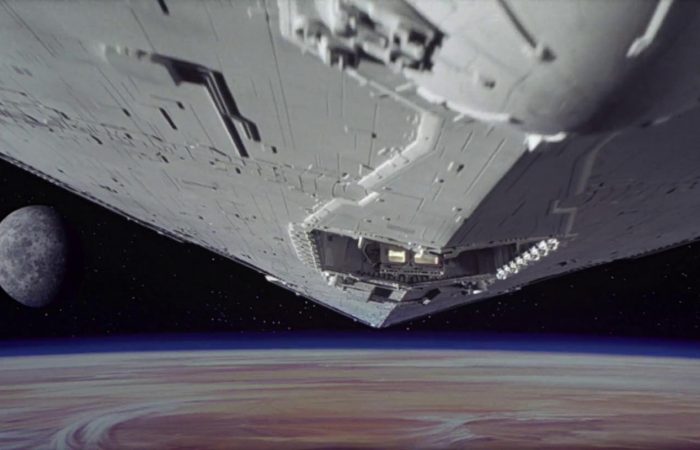
What world is your brand living in?
By Ed Lynes
The camera pans down from the opening crawl, and within seconds the screen is overwhelmed by the image of an imposing spaceship. The audience’s eardrums are rocked by the reverberations of its engines as the massive ship pursues its target. When the Imperial Star Destroyer appears in the first scene of Star Wars, George Lucas baptizes you in his universe in a way few storytellers have the audacity to attempt.
Star Wars comes up in a lot of conversations at Woden, and not just because we’re giant nerds (although, we are). We usually reference it as a universally understood representation of the hero’s journey. Yes, it’s a textbook example of the narrative arc, but just as important to the character of Star Wars is how boldly it embraces world building. In practically every scene, off-screen events are casually referenced to imply a wider world. But before any of that, without a spoken word of dialogue, George Lucas introduces you to a galaxy far, far away, and the stakes of the story he is telling.
Audiences appreciate that the narrative of a Star Wars film is only a segment of an ongoing story that begins long before the film starts and continues well after it ends. Thanks to three pretty great sequels (so far!), and three fairly atrocious prequels, that may be taken for granted now, but it was pretty daring in 1977. You possess the same opportunity when you set out to communicate your brand’s narrative: your audience will only participate in a narrow segment of the overall narrative that began the day you incorporated.
Even the most devoted fan of your brand will only see a sliver of its overall story — your challenge is to immerse them in a way that arrests their attention and connects with them immediately.
This immersion is impossible without a well-crafted brand story. If you have not yet defined your brand’s hero, embraced your mentoring role, and identified the problem you’re helping the hero solve, it’s impossible to create the kind of world someone is willing to lose themselves in. World-building delivers two key benefits: it fosters a powerful connection with your brand, and it also creates a community of people sharing experiences with the brand and each other.
That experience is bonded to the trust you have in your audience. Since you know they’ll never see the entire narrative arc, you must be confident they can fill in the blanks themselves. When Luke Skywalker first meets Obi-Wan Kenobi, he devotes less than two sentences to the subject of the Clone Wars. While the Clone Wars eventually consumed the better part of two films, a TV series, and countless books, Star Wars keeps the reference to a minimum and empowers the audience to draw its own conclusions.
This trust in the audience draws them in to the narrative, and invests them in the world by allowing and implicitly encouraging them to fill in the backstory themselves.
But here’s the rub: most brands don’t have their own Wookiepedia devoted to all the little minutiae of their brand story. So how do they envelop their audience in this way? It largely depends on a brand’s personality and voice.
Each Star Wars film will have an opening crawl, screen wipes, and a few key lines of dialogue (“I’ve got a bad feeling about this”). Your brand can do the same. Imagine your company were an actual person — who would they be? Write your content in a consistent voice that reflects that personality. Transform your social feeds into “their” feeds. Instead of curating general content about your industry, share original updates that your brand persona would write. When each message feels personal, it’s easy for your audience to feel that they know your brand.
The final piece of world-building is where many brands are least comfortable, but it is arguably the most crucial to inspiring true evangelism. Your audience is the hero of the story, which means, ultimately, they get to own it. You build the world, and guide them through it. But at some point, you must cede a level of control to your audience. Star Wars fans are passionate because they have been allowed to populate the world with their own stories — characters and flavor well beyond what exists in the official proprieties. Brands with equally dedicated evangelists trust them to speak for the brand, and encourage them to contribute their piece to the ongoing story.
Ed Lynes is a founding partner at Woden. Whatever your storytelling needs may be, let Woden help. Download our free StorytellingBlueprint, or send us an email at connect@wodenworks.com to discuss how we can help tell your story.


